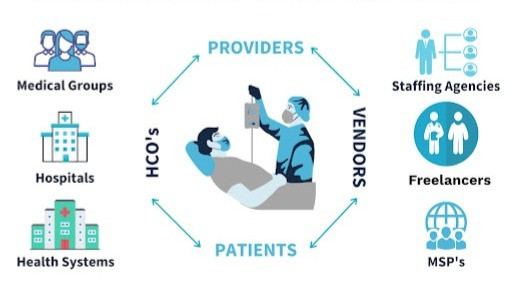The days of predictable full-time employees who have worked for the company for decades are gone. Today’s professionals search for roles allowing them to do what they love with little to no hassle. While offering more money is a nice incentive, flexibility is a higher priority for those entering the workforce.
Professionals often pick side gigs to leverage their free time and experience. A growing number of freelance and gig worker websites offer job seekers a historic amount of choice. So much so, that this group of workers now occupies a separate lane — an extended workforce.
An extended workforce is a group of non-employee workers who provide their skills and expertise to organizations to compensate for seasonal fluctuations, unforeseen departures or talent shortages. In short, it is another option for businesses (which commonly rely on staffing agencies) to find and manage contingent workers.
According to Staffing Industry Analysts, independent workers make up 18 to 30 percent of the workforce. Additionally, in planning and budgeting efforts, 60 percent of the non-employed/contingent workforce is unaccounted for. As a result, more organizations have to address how their model incorporates the not quite full-time employees.
While most industries are more flexible (and able) to accommodate gig workers, healthcare staffing challenges are more significant. Various factors, such as compensation models, compliance and reimbursement rules, make healthcare employment unique.
The relationship between healthcare professionals and facilities can be a series of interconnectivity. One full of tracking platforms and spreadsheets, differing processes and pay plans — all driven by high piles of tedious paperwork.
When considering healthcare and the regulations required to practice, a few simple commitments will drive your success:
-
One source of truth for internal employees versus external providers
-
A consistent classification system for providers by relationship type (W2, 1099, moonlighter, agency) and other ways to differentiate pay and utilization
-
Analytics aligned to help drive consistent, progressive compliance management and utilization reporting
-
Technology that manages all of the above without redundant data entry
So, where should you start?
Assess your central needs
Take an internal audit of your organization's workforce challenges. Are you not able to accurately estimate your spending on freelance and gig workers? Do you spend hours going from tab to tab or spreadsheet to spreadsheet to complete your schedule? Or, are you having trouble maintaining compliance and classification of workers? Has a shift been missed because of the disconnected systems?
You can't fix what you don't understand. If 20 percent or more of your shifts are filled with non-core or non-full-time staff, then a high-level operations audit can help you identify potential problems.
Use technology to bridge the gap
Unfortunately, most legacy enterprise resource planning systems do not adapt to this new workforce dynamic. As a result, teams experience a series of issues, including redundant data transfer processes.
Investing in the right technology can help teams more effectively manage resources. But sometimes, you've already invested so much into the systems you have, and introducing another can feel overwhelming. Even worse, you may not even be able to justify purchasing it. However, integrating this system through an API or other automated data exchange is essential in today's constantly expanding technology offerings.
Scheduling platforms with open APIs can help you in various ways, including better data access, error reductions and faster business processes. Navigating these challenges can be difficult, but it doesn't have to be. The extended workforce is the future of work; it's crucial to leverage available resources and design your operations to take advantage.
Kimedics seamlessly bridges the data exchanges between recruiting, onboarding, credentialing, operations/scheduling, finance and payroll.
Whether it's recruiting, onboarding, credentialing, operations/scheduling, finance or payroll, Kimedics seamlessly bridges the data exchange gap.
You want a platform that conforms to your process. Suppose you use some legacy systems you wish to retain. With Kimedics' open API, you can integrate other systems enabling integration.
The extended workforce is here to stay, so it's time to start evaluating how to best manage your teams. If you're looking for new technology to consolidate your scheduling efforts, our team can help.


